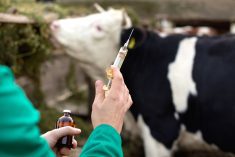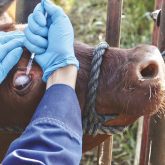Little is known about the impact of parasites on Canadian cattle production. But one thing is sure — resistance to the medication used to treat these parasites is growing.
“There’s a lack of local information and a lack of information on parasites in Canada. That’s a problem,” John Gilleard, professor of parasitology in the University of Calgary’s School of Veterinary Medicine, said at last month’s Canadian Beef Industry Conference.
Parasites live in the gastrointestinal tract and produce eggs which are passed in the feces. These eggs develop in the pasture, and are reingested when animals graze.
Read Also

Moo translator and methane measures: There’s an app for that
Dalhousie University researchers use artificial intelligence to create new dairy farm apps that analyze cattle sounds and measure methane.
These parasites cost Alberta’s cattle industry tens of millions of dollars a year — and perhaps quite a bit more — in lost production and treatment costs. For all of North America, the bill is estimated to be more than $2 billion annually.
Cold winters kill some parasites in this part of the world, but many survive inside their hosts as adult worms and some eggs can survive inside the soil with adequate snow cover.
“But to be honest, we don’t really know the extent of how much that happens,” said Gilleard. “That’s just an example of how much research we need to do.”
Parasites have always existed in the intestines of domestic cattle.
“The objective is not to eliminate parasites completely; it’s impossible to do that,” he said. “The aim is to keep them managed so they don’t have a negative impact.”
Cherie Copithorne-Barnes, a rancher from Jumping Pound, managed a large operation in Uruguay with her husband for seven years.
“In Uruguay, parasites can affect about 25 per cent of your production if you’re not managing it properly,” she said. “In the States, where it’s warmer, it’s about two to five per cent. In Canada, it doesn’t really rank.
“But the reality is that in a certain area, if you start to see that parasite impact on them, you don’t know what that amount is because nobody has started to measure what it is we’re fighting and what we’re doing here.”
But research dollars for parasite studies are hard to come by.
“It’s going to take some lobbying and some help pushing producers to start to help folks recognize that this is an issue,” Copithorne-Barnes said during a panel discussion.
Hidden hazard
The impact of parasites is hard to measure.
“It’s not animals that look sick or are in poor condition, necessarily, but their growth rate is impacted negatively,” said Gilleard.
Canadian parasite populations are strikingly different to the ones found in the U.S. Midwest.
“We have lower burdens of parasites overall, but we have more of the more damaging parasites here,” said Gilleard.
One American study conducted by a pharmaceutical company found animals treated with a subcutaneous injection for parasites gained 0.1 to 0.5 pound more per day than untreated ones in a control group.
Ivermectin and other pour-ons, which has been around for 30 years, has been the main treatment method. But these controls are losing their effectiveness, as internal parasites develop resistance. And pour-ons aren’t as good as oral medication, as only a fraction of the treatment makes it to the worms.
“Resistant worms in cattle are insidious. The cattle are not dying or getting sick, but products are losing efficacy,” said Gilleard.
Many producers have been using these controls unnecessarily and losing profit because they’re not using them properly. However, there are other, more effective ways to control worms and to prevent resistance.
For example, overgrazing can be a source of infection, since eggs are more likely to be at the base of a plant. Fecal egg counts (testing can be arranged through a vet) can be used to assess parasite burdens, and taking a fecal sample two weeks after parasite treatment can measure its efficacy.
Using the correct dewormer is also a good strategy.
“Most people are using pour-ons to control ecto parasites, not internal. Every time you use that pour-on, you are selecting for resistance of internal parasites,” said Gilleard.
Even though it sounds counterintuitive, it’s better to overdose than underdose, since underdosing reduces effectiveness of the treatment while selecting for resistance. If there are higher levels of parasites present, it’s best to treat cattle about six weeks after turnout to get the biggest production benefit.
Using Ivermectin and Fenbendazole in combination can also kill more parasites while reducing resistance.
And finally, be careful when bringing new cattle.
“When you buy cattle and put them on your pastures, you are seeding your pastures with the parasites that you just bought,” said Gilleard.
















